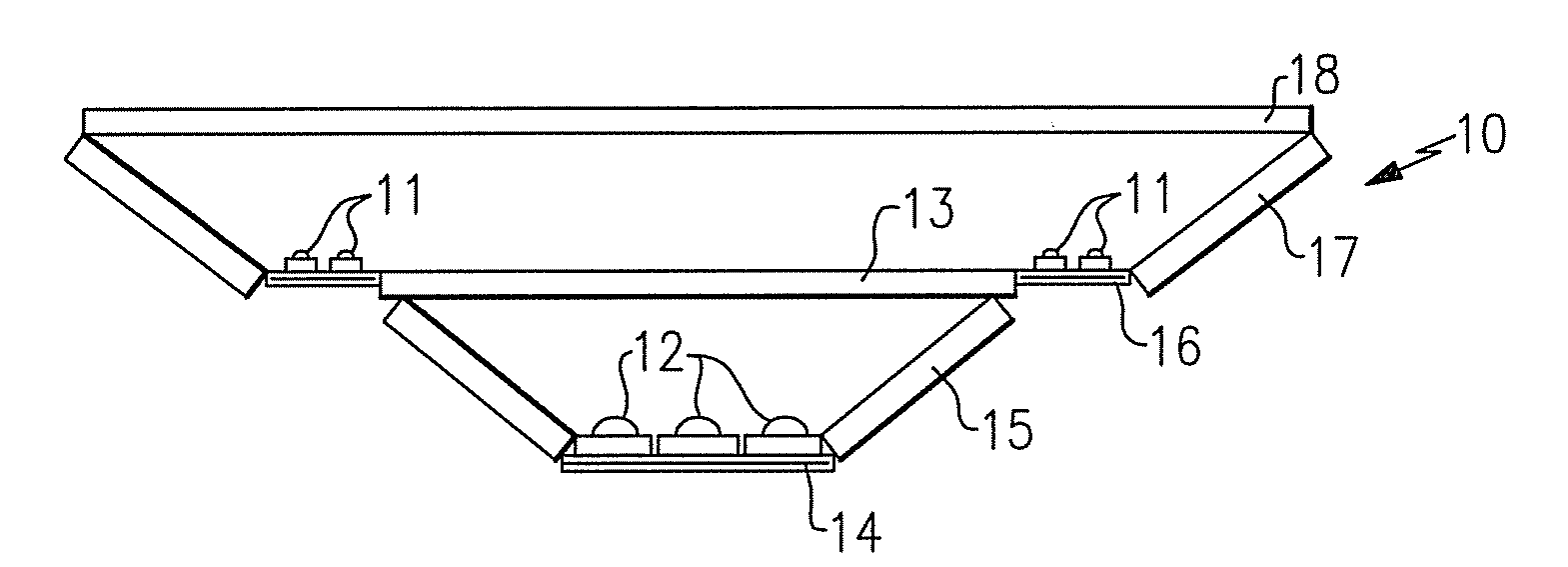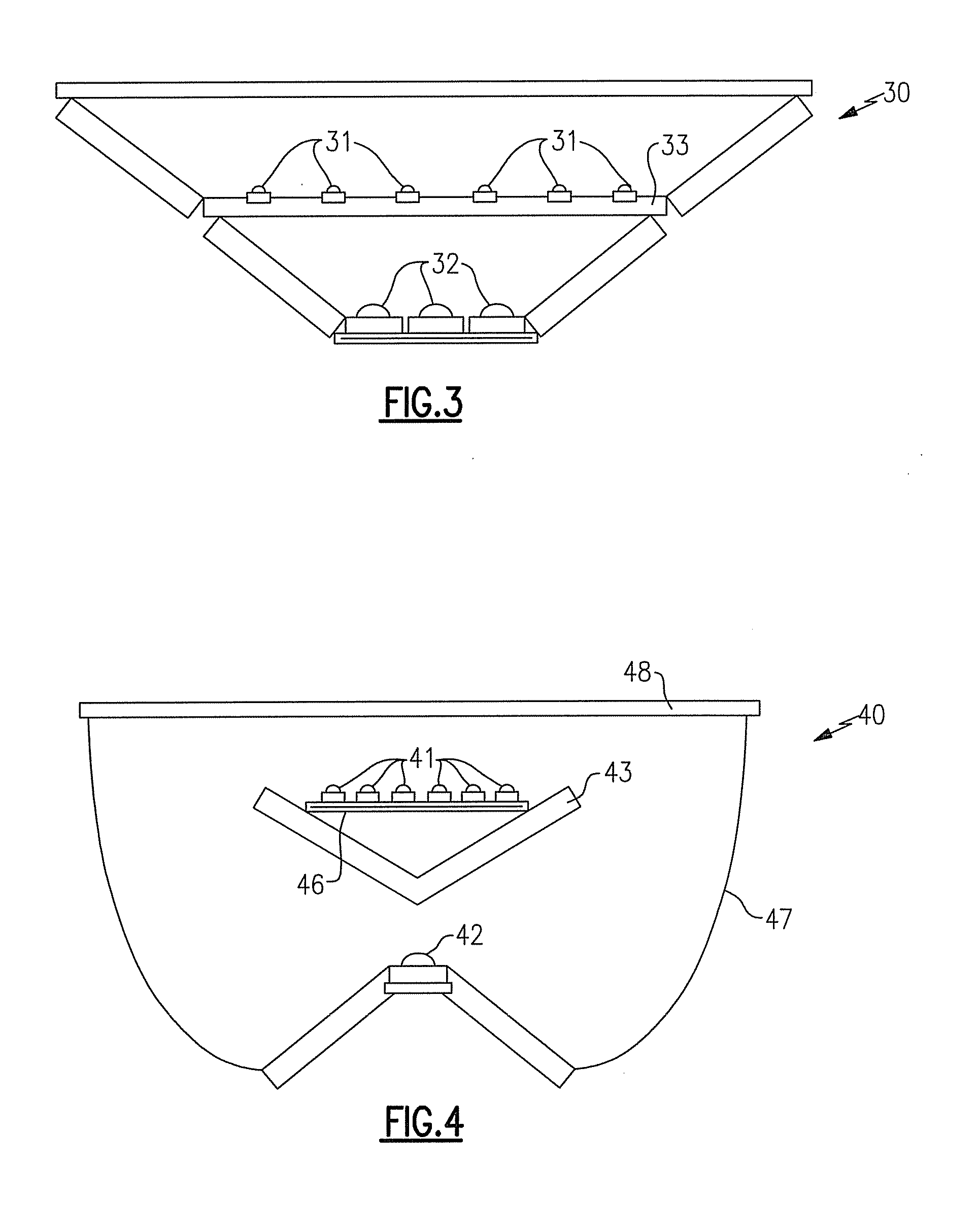Solid state lighting devices having remote luminescent material-containing element, and lighting methods
a technology of luminescent material and lighting device, which is applied in semiconductor devices, lighting and heating apparatus, light source combinations, etc., can solve the problems of incandescent light bulbs that incandescent light bulbs are relatively short life cycles, and incandescent light bulbs are very energy-inefficient light sources. , to achieve the effect of reducing the depth of the device, reducing the dimension of the device, and less spa
- Summary
- Abstract
- Description
- Claims
- Application Information
AI Technical Summary
Benefits of technology
Problems solved by technology
Method used
Image
Examples
fourth embodiment
[0192]In the above description of the fourth embodiment, the luminescent material-containing element 43 is a reflector that has a phosphor. Alternatively, the luminescent material-containing element 43 can be a luminescent material (e.g., a phosphor) that can be a reflector or an element that can act as a luminescent material, or a reflector, or both.
[0193]The first group of solid state light emitters 41 can include light emitting diodes that emit red light, the second group of solid state light emitters 42 can include light emitting diodes that emit blue light and the luminescent material can be a phosphor that emits yellow light.
[0194]The lighting device 40 can utilize a single blue light emitting diode (alternatively, there could be plural blue light emitting diodes, if desired) that shines onto a phosphor-coated highly reflective diffuser white reflector as the luminescent material-containing element 43. The blue light emitting diode can be supported on a conic pedestal which al...
first embodiment
[0208]The expression “emission plane of a solid state light emitter,” (e.g., “an emission plane of the first solid state light emitter”), as used herein, means (1) a plane that is perpendicular to an axis of the light emission from the solid state light emitter (e.g., in a case where light emission is hemispherical, the plane would be along the flat part of the hemisphere; in a case where light emission is conical, the plane would be perpendicular to the axis of the cone), (2) a plane that is perpendicular to a direction of maximum intensity of light emission from the solid state light emitter (e.g., in a case where the maximum light emission is vertical, the plane would be horizontal), (3) a plane that is perpendicular to a mean direction of light emission (in other words, if the maximum intensity is in a first direction, but an intensity in a second direction ten degrees to one side of the first direction is larger than an intensity in a third direction ten degrees to an opposite ...
second embodiment
[0225]In some embodiments in accordance with the present inventive subject matter, the first solid state light emitter is mounted on a first support element, and the luminescent material-containing element defines a luminescent material-containing element opening in which the first support element is positioned. For example, in the second embodiment described above, each of the solid state light emitters in the first group of solid state light emitters 21 is mounted on a first support element (the substrate 26), and the annular luminescent material-containing element 23 defines a luminescent material-containing element opening in which the first support element 26 is positioned.
[0226]In some embodiments in accordance with the present inventive subject matter, the first solid state light emitter is mounted on the luminescent material-containing element. For example, in the first embodiment (and similarly in the second, third and sixth embodiments) described above, each of the solid s...
PUM
| Property | Measurement | Unit |
|---|---|---|
| CRI | aaaaa | aaaaa |
| transparent | aaaaa | aaaaa |
| dominant wavelength | aaaaa | aaaaa |
Abstract
Description
Claims
Application Information
 Login to View More
Login to View More - R&D
- Intellectual Property
- Life Sciences
- Materials
- Tech Scout
- Unparalleled Data Quality
- Higher Quality Content
- 60% Fewer Hallucinations
Browse by: Latest US Patents, China's latest patents, Technical Efficacy Thesaurus, Application Domain, Technology Topic, Popular Technical Reports.
© 2025 PatSnap. All rights reserved.Legal|Privacy policy|Modern Slavery Act Transparency Statement|Sitemap|About US| Contact US: help@patsnap.com



